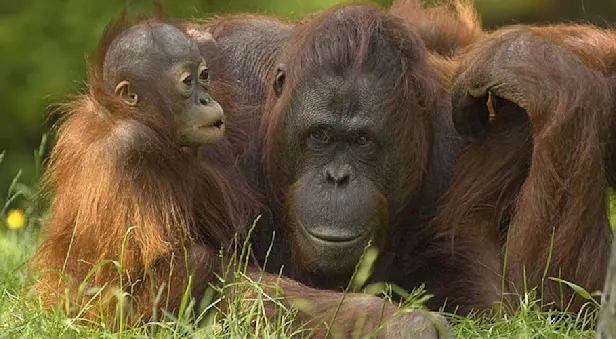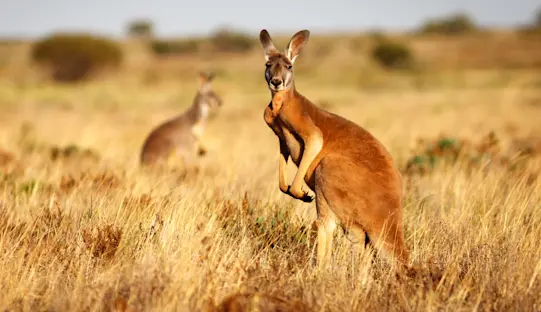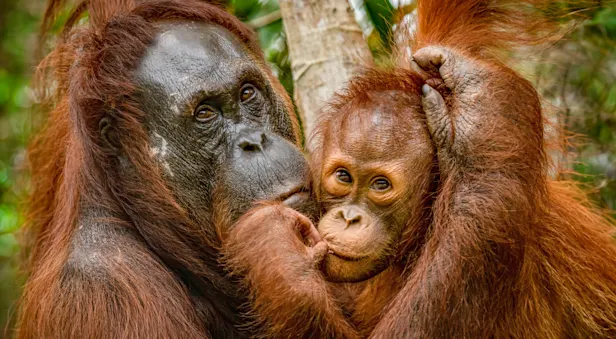
Know Before You Go


Borneo's Mammals | Borneo Wildlife Guide
Sunda Flying Lemur
The flying lemur, also known as the colugo or the "flying squirrel of Southeast Asia," is found throughout the rainforests of Borneo. Despite its name, the flying lemur is not actually a lemur and does not have the ability to fly. Instead, it is a gliding mammal that uses its large, thin skin membranes between its fingers and toes to glide from tree to tree.
The flying lemur is a nocturnal animal that spends most of its time in the rainforest canopy, feeding on leaves, flowers and fruit. It has a small, slender body covered in soft, dense fur, typically brown or gray.
One of the flying lemur's most distinctive features is its large, round eyes, which are adapted for night vision and help the animal locate its food in the dark. The flying lemur is also known for its long, thin tail, which it uses to balance while gliding.
While the flying lemur is not a well-known animal, it is an important part of the ecosystem in Borneo and plays a key role in seed dispersal and pollination. Despite this, the flying lemur is at risk due to habitat loss and deforestation, which are threatening its survival.
Large Flying Fox
The large flying fox is one of the largest bats in the world, with a wingspan of up to 60 inches. It inhabits tropical forests, swamps and oceanic islands.
The bat can eat half of its body weight in flowers, nectar and fruit on a daily basis. Due to its larger size, the flying fox plays an important role as a pollinator and seed disperser because not many flying animals can carry the large fruits they feed on. If these bats were to disappear from Borneo, the composition of the rainforest would change dramatically.
The large flying fox is commonly hunted for food and sport throughout its geographic range. There is an international legal and illegal market for its meat and by-products. An estimated 22,000 flying foxes are legally hunted annually in Peninsular Malaysia.
These bats are also often viewed as agricultural pests, as many of their forage sites include fruit farms. They also carry a number of zoonotic diseases, like the Hendra virus and the Nipah virus. The long-distance movements of large flying foxes increase their potential to transfer these diseases to other countries in Australasia.
Slow Loris
The slow loris is a small arboreal primate, typically weighing less than 4.5 pounds. It is almost never observed out of the treetops, although it moves with a wavering trot when it’s on the ground.
These primates have extra vertebrae in their backs, giving them a greater tree-climbing advantage since they can twist around above and below branches. Slow lorises are mainly solitary and mark trees with their urine to avoid direct conflict with other individuals. They do this by urinating on their hands and wiping the urine onto tree trunks and branches.
Captive studies have shown that the slow loris produces a polypeptide toxin from the arm's brachial gland. When mixed with saliva, it repels at least some predators, which may explain why mothers cover their babies with saliva when they leave them. Biting may also be a way of delivering the toxin. The toxin apparently gets into the saliva when the animal licks its brachial glands. The narrow spaces between the teeth of the toothcomb in the lower jaw act as capillaries, drawing the saliva and toxin into whatever the animal is biting. While the activity and use of the toxin need to be examined in the field, Indigenous peoples of Indonesia regard the animal as venomous.
There are many superstitions and beliefs about the slow loris. Lorises, or parts of them, are claimed to have remarkable powers of good and evil. In addition, their fur is said to speed the healing of wounds; if a ship carries one as a mascot, it is never becalmed.
Western Tarsier
Western Tarsiers prefer primary and secondary forests, although they can also be found in mangroves and forest edges. These vertical clingers and leapers generally do not venture into more open areas unless enough prey and small-diameter trees to cling to are present.
The most striking feature of the tarsier is its large eyes, which allow them to hunt at night. They are larger compared to their body size than those of any other mammal.
The primate’s arboreal nature keeps them out of reach of most predators; however, snakes and arboreal mammals (e.g., slow lorises) are likely their primary predators.
Western tarsiers are exclusively carnivorous, most commonly feeding on insects. They consume almost any kind of insect, as well as some small vertebrates, including birds, mammals and reptiles.
Differing from other tarsiers, the western tarsier is quite solitary. It comes in contact with other members of its species only for mating, establishing territory, or raising young. Western tarsiers often return to the same general area to sleep, if not to the same perch.
Pigtail Macaque
Pigtail macaques live in rainforests and swamps at elevations ranging from sea level to above 6,500 feet.
They have light brown hair covering their bodies and white underbellies. The hair on the top of their heads is either dark brown or black. Males have mane-like hair around their faces. Pigtail macaques also have long legs and hairless snouts.
These primates move around on the ground and throughout the trees on all fours, spending most of their time in the trees, with less than 10% of their time on the ground.
A primarily frugivorous animal, they also eat insects, seeds, leaves, dirt and fungus. Other foods in their diet include nestling birds, termite eggs, larvae and river crabs. Pigtail macaques divide into small groups to forage for food on the ground. They range widely when searching for food and are known for raiding the fruit crops of farmers. They will set up a guard to look for humans and shout a warning signal to those in the fields.
Pigtail macaques have been described as silent monkeys because they seem to be very quiet. When seen running away after an episode of crop raiding, pigtail macaques are almost completely silent.
Common Palm Civet
The common palm civet is a cat-like predator found in tropical forested habitats from Kashmir in the west to the Philippines in the east, from southern China and the Himalayas in the north to the Greater Sundas and many lesser Sunda Islands in the south.
The palm civet has a distinctive appearance, with a long, slender body and a pointed snout. It is covered in short, dense fur that is typically dark brown or black. It is well-adapted to a solitary life in the tree canopy, where it hunts at night using its keen senses of smell and hearing to locate prey.
It is an omnivorous animal and feeds on various plants and animals, including fruits, insects, small mammals and birds. It is known for its love of coffee berries and is sometimes used in the production of specialty coffee known as "civet coffee," which is made from the beans that have passed through the digestive system of the palm civet.
Despite its small size, the palm civet is an important predator and seed disperser in the Borneo ecosystem. However, like many other species in the region, it is at risk due to habitat loss and deforestation.
Leopard Cat
The leopard cat is one of the most widespread carnivore species in Asia and can be found in tropical, temperate forests and coniferous forests, as well as shrublands and grasslands throughout most of southern Asia.
The leopard cat is an exceptional swimmer, which explains its distribution on islands. It cannot withstand temperatures above 95 degrees Fahrenheit, which explains its absence from central India. However, the animal can live at higher elevations (i.e., 9,800 feet) with minimal snowfall.
These wild cats are the size of large housecats, weighing an average of between 7 and 13 pounds. They typically have pale, tawny fur with a white belly, and their body and tail are covered with rosettes. The tails are often ringed at the tip.
Leopard cats are ambush predators that thrive in forested habitats near water sources. Although they are classified as nocturnal, they are occasionally seen during the day. They primarily prey on small terrestrial vertebrates but will attack aquatic prey when they encounter it.
These are solitary creatures that spend their time roaming throughout their home ranges hunting. They are exceptional climbers, which allows them to prey upon birds and bats. However, they are mainly found on the ground.
They are frequently found on the outskirts of rural and agricultural areas, which presents a unique risk to them and to domestic cats. Despite this, they are difficult to observe as they are elusive and small.
Leopard cats can be carriers of potentially fatal domestic cat diseases, such as Feline Immunodeficiency Virus (FIV). Areas with a high rate of infected domestic cats also have many infected leopard cats.
Bearded Pig
The bearded pig is a species of pig found throughout Southeast Asia. It has a slim torso and a long head. It is distinguished by its white beard hair, thin whiskers and two-rowed tail tuft. Bearded pigs have a keen sense of hearing and smell, and their snouts are adapted for digging in the ground for food, such as earthworms, roots, and fruit and gum tree seedlings. They also feed on dead fish that wash ashore on the coast.
Bearded pigs are active during the day, except during times of migration when they switch to being active at night. Old boars lead extensive migrations and occur at the same time each year along predictable routes. These migrations may be due to variations in food supply or a regular migratory cycle. However, due to their lack of shyness during migration and the predictability of their movements, bearded pigs are an easy target for humans to hunt. They are used as a reliable source of meat once a year.
See Borneo's Wildlife on These Nature Safaris

The Wilds of Borneo: Orangutans & Beyond
Plumb some of the world’s oldest and tallest rainforests in search of wild orangutans and other jungle wildlife among diverse ecosystems on this matchless tropical nature adventure.
































